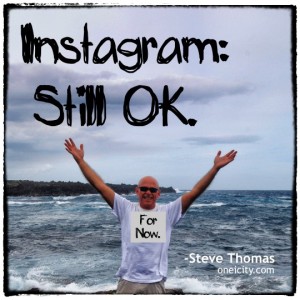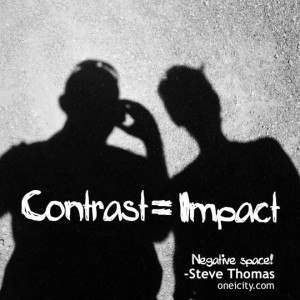 You’ve certainly heard of the wonderful visually-based social media tool called Instagram (assuming you’ve had electricity in the last 6 months). But have you heard about the “instastorm” (my term)?
You’ve certainly heard of the wonderful visually-based social media tool called Instagram (assuming you’ve had electricity in the last 6 months). But have you heard about the “instastorm” (my term)?
Word bubbling through the web and social media is that come January Instagram will beginning selling your children’s photos! Scary! But stay with me . . .
In seminars and with clients I’ve been recommending that orgs and professionals play with Instagram. Literally the day Instagram’s daily users exceeded Twitter’s daily users I began saying that you “couldn’t ignore it.” But most of us are still trying to figure out what to do with an image-based social platform that has a nearly vertical growth curve.
In the last few days the news has been bouncing around that Instagram has new terms of service coming in mid-January that will give Instagram the right to sell your images . . . of particular concern: images of you’ve posted of your children. Well you can see why that might light people up.
I received a few emails of concern. And a couple of emails that, in my reading between the lines, were gloating a bit that I’d recommended something they had “known all along” was a bad, bad idea.
OK, first. In seminars and with clients, we always draw the distinction between digital content that you own and content that you don’t own. Someone I’ve read uses the phrase “own” versus “rent.” (I can’t remember who said that, so if you did, let me know and I’ll give you credit.)
Anyway, you don’t own anything on any social media platform. They do. And they can change the rules of the game and/or make your content on their site disappear. It’s just a rule of the game. They’re providing the platform and they own it. They can do what they want — whether you think it’s stupid or not.
Your website is yours (at least I hope you haven’t made any other arrangements). Your website is your base, your hub, your foundation, your mothership . . . social media rotates around it or feeds it . . . those tools connect to your content mothership (your website).
And you need to be prepared for any social media rules to change to the extent that you no longer want to use it. If Twitter does something stupid either by forcing a pay-for-use model or similar — walk away. Another new channel will form and grow and you can use the new one.
Remember social media is fluid and the social media users are fluid. Doesn’t that mean social media is a bad thing? Not really, it’s just a different thing. There are too many opportunities and too many of your donors (and future donors) on social media for you to ignore it. But you can’t think of social media like you think of your website: Social media is disposable like a zillion other tools and channels you use (direct mail, magazines, brochures, billboards, etc.). Never get too attached to any platform or tool. That’s a bad social media strategy; I’m not saying social media is bad.
So what are the takeaways?
First, on the Instagram Instastorm here’s something clarifying the issue (sorta). ***Editorial note: Late Wednesday 12/19, Instagram’s CEO said, “Instagram users own their content and Instagram does not claim any ownership rights over your photos. Nothing about this has changed.”***
Second, wait to worry (there’s even some good Bible on that). We have until mid-January. Don’t sweat it for now. Wrap up 2012 then sort out the complications of 2013. One of the things we may see play out is the power of the user to influence a bad choice. Instagram doesn’t want everyone to flee their platform, they need us. So we’ll see what happens.
Third, if you need a contingency plan now . . . look at Snapseed (app and desktop). I use it far more than Instagram. If Instagram does a dumb-thing, I’ll switch over to Snapseed 100% and I’ll be fine . . . because I’m posting images on Facebook and more importantly on our blog (which we own). You can do the same. You can see what I’m up to with visuals over on the Oneicity Facebook page.
Finally, PLEASE don’t think that because there’s this little storm over an Instagram thing that social media isn’t viable for you or that should you ignore the power of the visual. You have to think visual. Also, use this to remind important people about rented versus owned content. It’s usually worth it to have some rented or disposable content. But we all need to help everyone understand the differences and nuances.
Whew.
What about you? I’d love to know what you’re hearing about this dust up and what your plans are. Send me a photo — I promise not to sell it to anyone.
![]()
Steve Thomas
Partner, Oneicity
(photo credit: Steve Thomas)
Find Steve on Instragram: oneicity_st


11 thoughts on “social media fundraising: the instagram instastorm”
Panicking is never the right solution….ever.
@Brad — so true. Assuming the sun isn’t exploding, then panic is OK.
st
@St Disagree. If the Sun is exploding, panicking continues to add no value. **GRIN** Besides, Instagram’s CEO came out, yesterday, and said, “Whoops…nope…sorry, not selling your pictures.”
@Brad — Panic isn’t about adding value. It helps manage stress. It transfers it to other people, but that’s another blog post entirely.
st
Speaking as someone who always is a ‘late-comer’ to these new social media, ah gimmicks. Can someone explain why I would want to use Instagram in the first place? Is it just for folks who don’t have/use Photoshop? In other words, just for photo manipulation for use elsewhere? OR is this some new community (yet again), where there is more to it than simply altering images? Thanks!
For me – not being familiar with Instagram (I was waiting to have a longer conversation with you about it) it puts me in a suspicious frame of mind.
The frustration is the feeling of powerlessness that several of the platforms allow their customers to experience with a seemingly complete lack of concern about it. Impressions are everything on the Internet. I sit here having the impression that I will just experience the same aggravating incidences as I do with Facebook, and I think one is enough for me, right now. I really dislike the “Hey, it’s free” argument, because someone – somewhere – is making loads of money off of me sitting in front of my computer and participating in a platform. I may not give you my money, I say, but my time is valuable.
I was about to be an Instagram customer, and now I will not be. That’s either infromation to a company, or it’s not. Those are my short thoughts about it…
It’s good to always have a backup plan. We had a meeting about this yesterday. Before this happen – we saw people taking photos off our website and putting them on their’s. We had to ask them to take it down. The information is so easy to just take now. In the mean time, I downloaded your recommended SNAPSEED. Test it out – see how it works until they make a similar statement. The wild wild west of the web (social media included) is always changing and we move along with it. Bye Bye Instagram – say hello today to SNAPSEED.
@Kyle — Thanks for jumping in with such great questions (you know you’re asking questions other people didn’t have the nerve to ask). I’m not sure I’m the best guy to give a “what’s Instagram” answer, but I’ll try. Instagram has combined some pretty nifty photo filters (treatments and basic sweetenings) with a bit of a social media. So you can look like a better photographer than you are and friends connect with it and see it. (It buckles snuggly with Facebook, nearly seamlessly). One of the tricks we have up our sleeve in 2013 is that we’re doing some video interviews of leaders and experts and my buddy Jon has agreed to give us an Instagram lesson. He’s a world-class professional photographer and he rocks Instagram (he’s the one that turned me on to Snapseed). So. Instagram is photos and relationships. For people like us, we’re trying to use visuals to get a quick message to someone. Maybe think Twitter in Images (short-form messaging). Photoshop has such a steep learning curve that even photographers like me who have a lot of experience both behind the camera and in the darkroom (doesn’t that sound ancient?) can quickly and easily make our raw iPhone happy-snaps look nice. Is it good? Who knows from an art perspective, but from a business-communicator perspective, it’s pretty nifty technology.). Thanks again.
Hope this helps…and thanks for the questions.
(Oh, and about gimmicks, I always say, one person’s gimmick is another person’s strategy
st
@Joanne– I completely hear you.
And you put your finger on one of the frustrations of current social media world. Carol Patterson (1 comment below you) is either quoting me or I’m quoting her, because I remind clients all the time that: “social media is the wild west.” The rules are being formed as they go. And naturally everything is based in business models. What I’d say is that you have a narrow range of options to not experience this kind of frustration:
-Ignore Social Media: even Facebook (which is relatively stable) changes the rules because of what they need to do on the business side of their world. And, I believe that Social Media is too important and valuable for NPOs and business to ignore–it feeds conversations and builds relationships. We’ve seen wonderful evidence of social media referring and feeding online donations.
-Only do the “secure” social media platforms like Twitter and FB. I think this isn’t smart because none are secure, in my opinion. None. Any can change at any time….
So what do you do? Be platform agnostic and don’t get emotionally attached to any one platform. I am better on FB than any other platform. BUT if FB changes to where it doesn’t work for Oneicity or our clients, I’ll have other options because I’m always experimenting. I try keep my experiments cross-platform. For instance, most of my “business” Instagram shots were cross posted on FB and then on the blog. If I have to spend any time online professionally, I want maximum traction and maximum ROI on my time.
You totally rock FB, so just keep going with that but begin to experiment somewhere else. Chris Brogan calls it “creating an outpost.” Keep playing.
Love to have the conversation, anytime!
st
@Carol — interesting to have people pulling photos off your website for their use. Wild West indeed! I probably should say I don’t get any money from Snapseed, I just found it very helpful. Hat-tip, again, to Jon Anderson.
One thing I know you are good at is staying focused on the strategy and the results you’re driving for, that’s why you keep options in mind and can tack away from Instagram without a missing a beat.
Thanks so much for keeping things lively and real.
You’re the best.
st
Every thing is all about “trending.” We are forward of the curve with what’s sizzling and what isn’t.